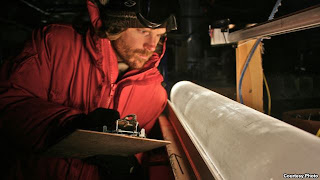 |
| Climate scientist studies ice core from Antarctica. (T. Bauska) |
The research, outlined in the online edition of the journal Nature Geoscience, said there had been an overall cooling trend across nearly all the world’s continents during the last 1,000 to 2,000 years. But that trend came to a halt in much of the world near the end of the 19th century, the study concluded, adding that the period between 1971 and 2000 was the warmest in 1,400 years.
The researchers, coordinated by the Past Global Changes (PAGES) project based in Switzerland, were able to make their conclusions by combining data from records that were taken from sources such as tree rings, pollen, corals, lake and marine sediments, ice cores, stalagmites and assorted historical documents taken from 511 locations throughout Earth’s seven continents.
The researchers said they expect their expansive new dataset will be used in future studies, including comparisons with the output of climate models used to help project future climate change.
Noting that climate records from Africa remain sparse, lead study author Darrell Kaufman, a professor at Northern Arizona University in Flagstaff, said, “There were too few records to accurately determine long-term temperature changes for that continent.”
The scientists noted that variations in temperatures across the continents were much more alike within their own hemispheres than between theNorthern and Southern Hemisphere.
"Distinctive periods, such as the Medieval Warm Period or the Little Ice Agestand out, but do not show a globally uniform pattern on multi-decadal time scales," says co-author Professor Heinz Wanner of the University of Bern.
The cooling trend was felt throughout the world by approximately 1500 AD when temperatures fell below the long-term mean nearly everywhere. However, the researchers noted, this drop in mean temperature took place centuries earlier in the Arctic, Europe and Asia than it did in North America and the Southern Hemisphere.
“These new findings will certainly stimulate vibrant discussions within the research community,” says Professor Wanner.
The researchers said the most common feature they found throughout the regions of the world was a long-term cooling trend. The study suggests that a combination of factors such as an increased global volcanic activity,decreased solar activity, changes in land cover, and slow changes to Earth’s orbit all contributed to the cooling trend.
The warming that began in the late 19th to early 20th century was twice as much, on average, in the northern regions of the world as it was in the Southern Hemisphere.
Antarctica has been the only continent so far to buck the warming trend.
The researchers analyzed the average temperatures over 30-year periods and found that the period from 1971 to 2000 was most likely warmer overall than any other 30-year period over the last 1,400 years.
But looking back further, the researchers found that there were some areas that experienced even warmer 30-year intervals than the 1971 to 2000 period. Europe during the Roman Empire, for example, was most likely warmer between 21 and 80 AD.
Weaker solar activity and an increase in tropical volcanic eruptions, on the other hand, may have produced some intensely cooler 30-year periods between 830 and 1910 AD. The researchers noted that both weakened solar activity and increased volcanic activity often took place at the same time which they say led to a drop in the average temperature during five distinct 30 to 90-year intervals between 1251 and 1820.
“Previous attempts to reconstruct temperature changes focused on hemispheric or global-scale averages, which are important, but overlook the pronounced regional-scale differences that occur along with global changes,” said Professor Kaufman. "A key aspect of the consortium effort was to engage regional experts who are intimately familiar with the evidence for past climate changes within their regions," he added.
"Several mathematical procedures were applied to reconstruct the continental temperature time series and they were compared to assess the extent to which the main conclusions of the study stood up to the different analytical approaches."
This study along with other work performed by the “PAGES” project is funded primarily by Swiss and U.S. national science foundations.
Source VOA


 9:20 AM
9:20 AM
 Trung
Trung

 Posted in:
Posted in:
0 comments:
Post a Comment